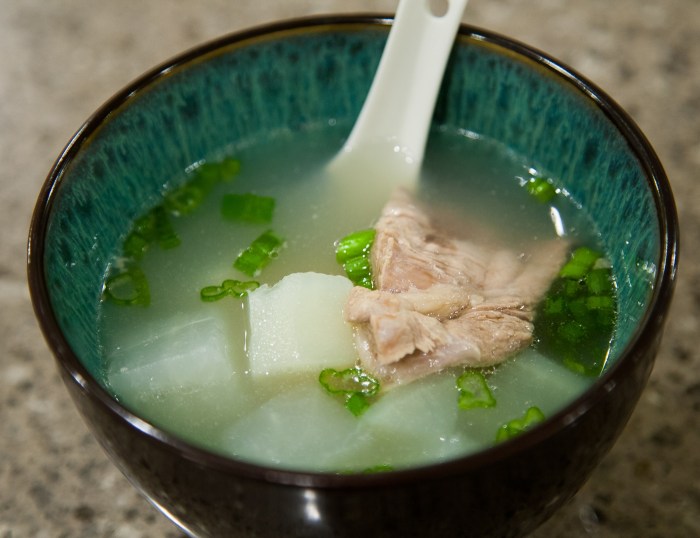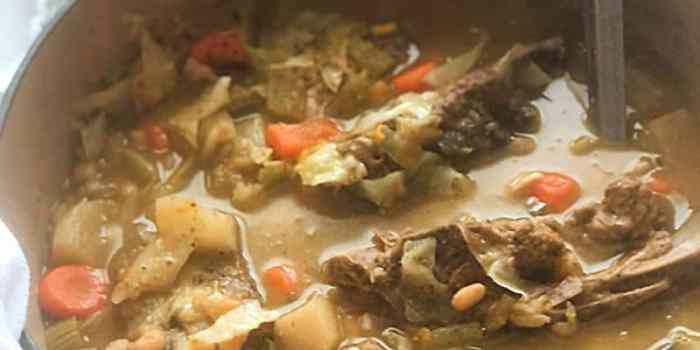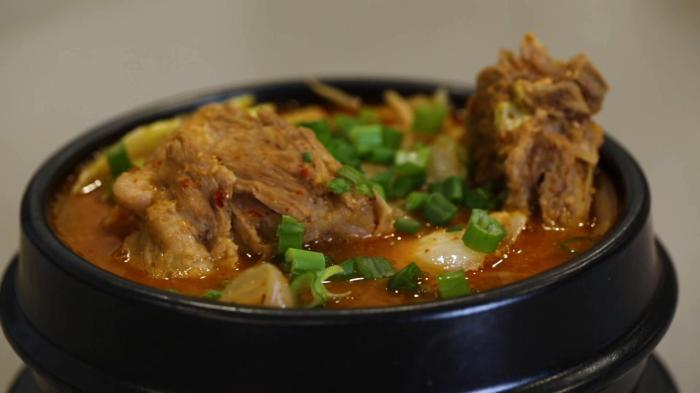Neck Bone Soup Recipe Variations

Source: asiancookingmom.com
A rich neck bone soup recipe often centers around long, slow simmering to extract maximum flavor. For a similar comforting experience, but with a different cultural twist, you might consider exploring a matzo ball soup manischewitz recipe ; the wine adds a unique depth. Returning to the neck bone soup, remember that adding vegetables like carrots and celery enhances the overall taste profile.
Neck bone soup, a hearty and flavorful dish, offers a surprising range of culinary possibilities depending on the regional influences incorporated. This exploration delves into three distinct variations, highlighting the unique characteristics of Southern US, Asian, and Caribbean styles. We will examine key ingredients, cooking techniques, and the resulting flavor profiles to demonstrate the versatility of this humble yet potent ingredient.
Regional Neck Bone Soup Recipe Variations

Source: soupstud.com
The following recipes showcase the diverse applications of neck bones in culinary traditions around the world. Each recipe emphasizes distinct flavor profiles achieved through specific ingredients and cooking methods.
- Southern US Style: This version emphasizes a rich, savory broth with smoky undertones. Key ingredients include neck bones, onions, celery, carrots, garlic, bay leaves, black peppercorns, and a touch of smoked paprika. The long, slow simmering process extracts maximum flavor from the bones, resulting in a deeply satisfying soup. The cooking method involves a combination of browning the bones initially to develop a rich flavor, followed by a long simmering period to extract collagen and create a thick broth.
- Asian Style: This recipe incorporates elements of Asian cuisine, featuring ginger, soy sauce, rice wine, and shiitake mushrooms alongside the neck bones. The broth is lighter and more nuanced than the Southern US version, with a savory-umami balance. The cooking method often involves a quick sear of the bones followed by simmering in a flavorful broth. Star anise and five-spice powder can add further depth.
- Caribbean Style: This vibrant version utilizes a blend of Caribbean spices like scotch bonnet peppers, allspice, thyme, and a touch of coconut milk. The broth is infused with a complex array of warm, spicy, and subtly sweet notes. The cooking method typically involves a quick sauté of aromatics followed by simmering with the neck bones and spices. The addition of root vegetables like yams or sweet potatoes contributes to the richness and sweetness.
| Recipe Name | Primary Flavor Profile | Key Ingredients | Cooking Time |
|---|---|---|---|
| Southern US Neck Bone Soup | Rich, Savory, Smoky | Neck bones, onions, celery, carrots, garlic, bay leaves, black peppercorns, smoked paprika | 6-8 hours |
| Asian-Style Neck Bone Soup | Savory-Umami, Light | Neck bones, ginger, soy sauce, rice wine, shiitake mushrooms, star anise, five-spice powder | 4-6 hours |
| Caribbean Neck Bone Soup | Spicy, Sweet, Savory | Neck bones, scotch bonnet peppers, allspice, thyme, coconut milk, yams/sweet potatoes | 3-4 hours |
Sourcing and Preparation of Neck Bones, Neck bone soup recipe
The quality of your neck bones significantly impacts the final flavor of your soup. Proper preparation is equally crucial for maximizing flavor extraction and ensuring food safety.
- Sourcing: Opt for fresh, high-quality neck bones from reputable butchers or sources committed to ethical and sustainable practices. Look for bones with a pale pink color and minimal discoloration. Avoid bones that smell foul or show signs of spoilage.
- Preparation: Begin by rinsing the neck bones thoroughly under cold water to remove any debris. Trim away any excess fat, gristle, or sinew. Blanching the bones for a few minutes in boiling water helps remove impurities and improves the clarity of the broth. Image 1: A close-up showing the removal of excess fat from the neck bone. The fat is a glistening white, and the bone is a pale, pinkish color.
Image 2: The neck bones submerged in boiling water during the blanching process, steam gently rising from the surface. Image 3: The neck bones after blanching, slightly lighter in color and visibly cleaner.
- Flavor Maximization: To extract maximum flavor, roast the bones before simmering them. This process creates a deeper, richer flavor that infuses the broth. Alternatively, start by searing the bones in a hot pan to brown them and create a flavorful base for the soup.
Broth Enhancement Techniques
Several methods can enhance the depth and richness of your neck bone broth. These techniques elevate the basic broth into a complex and flavorful culinary experience.
- Roasting: Roasting the bones before simmering intensifies the flavor and creates a deeper, richer broth.
- Searing: Searing the bones in a hot pan before adding them to the broth adds a layer of depth and complexity.
- Adding Aromatics: Incorporating herbs and spices like bay leaves, thyme, rosemary, garlic, and onions enhances the broth’s aroma and flavor.
- Using Vinegar: Adding a splash of vinegar (apple cider vinegar or white wine vinegar) helps extract minerals from the bones, enriching the broth’s flavor.
- Adding Vegetables: Including vegetables like carrots, celery, and onions not only adds flavor but also contributes nutrients and enhances the broth’s overall richness.
Serving Suggestions and Variations
Neck bone soup’s versatility extends to its presentation and accompanying dishes. The following suggestions showcase ways to elevate this simple yet satisfying dish.
- Serving Suggestion 1: Serve with crusty bread for dipping into the flavorful broth.
- Serving Suggestion 2: Pair with a side of steamed greens or a simple salad for a balanced meal.
- Serving Suggestion 3: Add cooked noodles or rice for a heartier soup.
- Serving Suggestion 4: Garnish with fresh herbs like parsley or cilantro for added freshness.
- Serving Suggestion 5: Serve with a dollop of sour cream or crème fraîche for a creamy contrast.
- Variation 1 (Adding Vegetables): Incorporating root vegetables like turnips or parsnips adds sweetness and earthiness.
- Variation 2 (Adding Noodles): Adding egg noodles or rice noodles provides a textural contrast and extra carbohydrates.
- Variation 3 (Adding Greens): Adding kale or spinach provides nutrients and a vibrant green hue.
- Variation 4 (Adding Meat): Adding shredded chicken or beef adds protein and a different flavor profile.
- Variation 5 (Adding Beans): Adding beans like black beans or kidney beans adds protein and fiber.
Nutritional Aspects and Health Benefits

Source: buzzfeed.com
Neck bone soup offers a wealth of nutritional benefits, stemming from the collagen-rich bones and the addition of vegetables and other ingredients.
| Nutritional Benefits | Source |
|---|---|
| High in collagen, promoting joint health | Neck bones |
| Rich in minerals like calcium and phosphorus | Neck bones |
| Provides essential vitamins and antioxidants | Vegetables and herbs |
| Good source of protein | Neck bones and added meats (if any) |
Expert Answers
Can I use frozen neck bones?
Yes, but thaw them completely before use to ensure even cooking. Allow ample time for thawing in the refrigerator.
How long can I store leftover neck bone soup?
Store leftover soup in airtight containers in the refrigerator for up to 3-4 days. It can also be frozen for longer storage.
What if my soup is too salty?
Add a peeled and halved potato to the soup during the last 30 minutes of cooking. The potato will absorb some of the excess salt.
Can I use other types of bones?
While neck bones are ideal, you can experiment with other bones like beef shanks or oxtails, adjusting cooking time accordingly.
What are the best vegetables to add to neck bone soup?
Root vegetables like carrots, parsnips, and turnips work well, as do leafy greens like collard greens or kale added towards the end of cooking.
